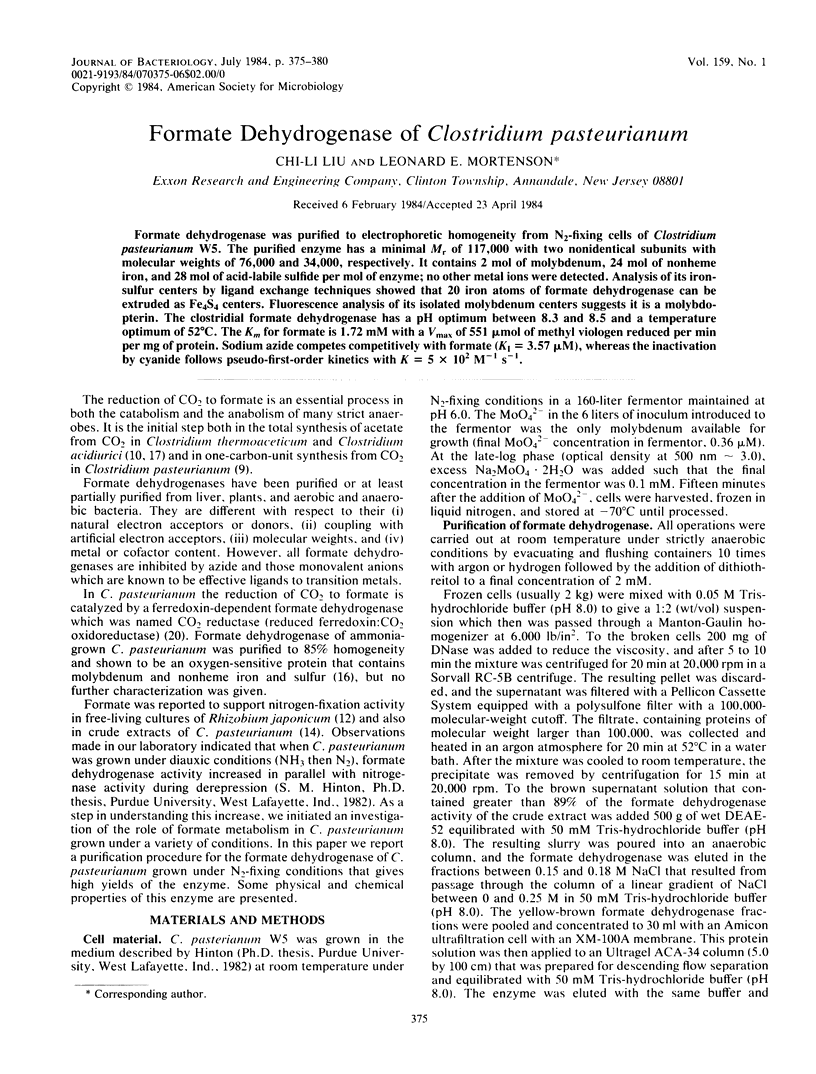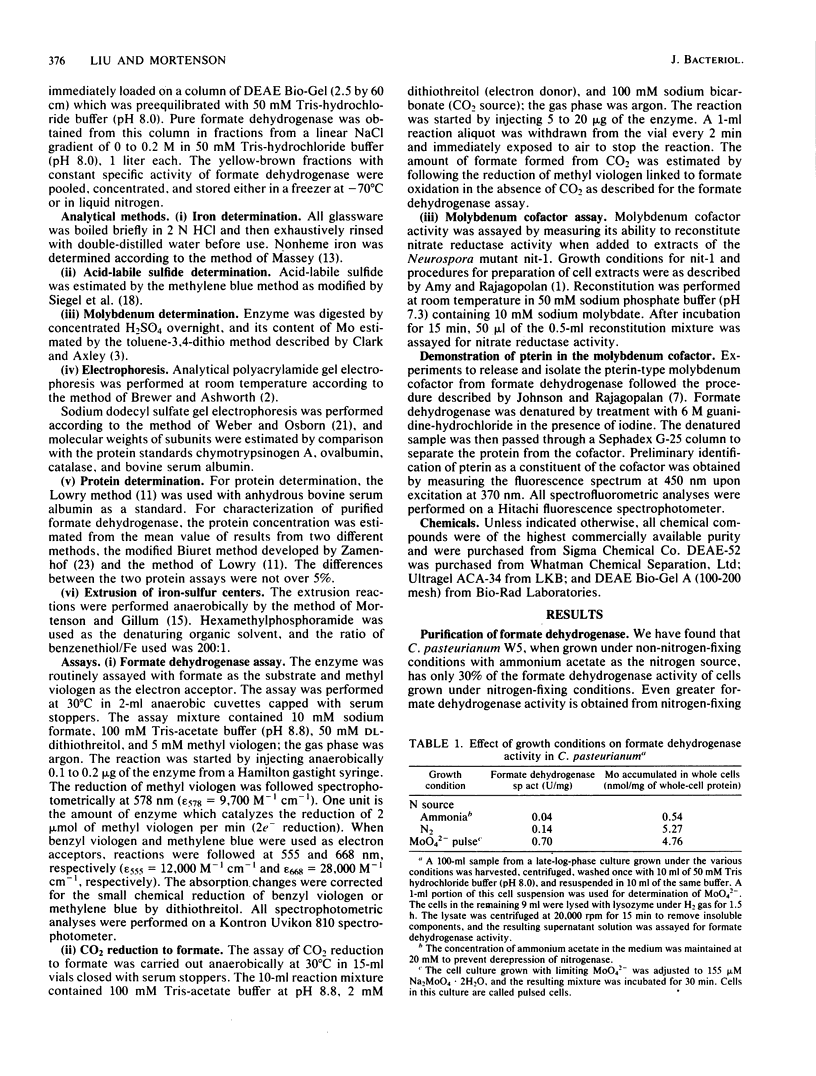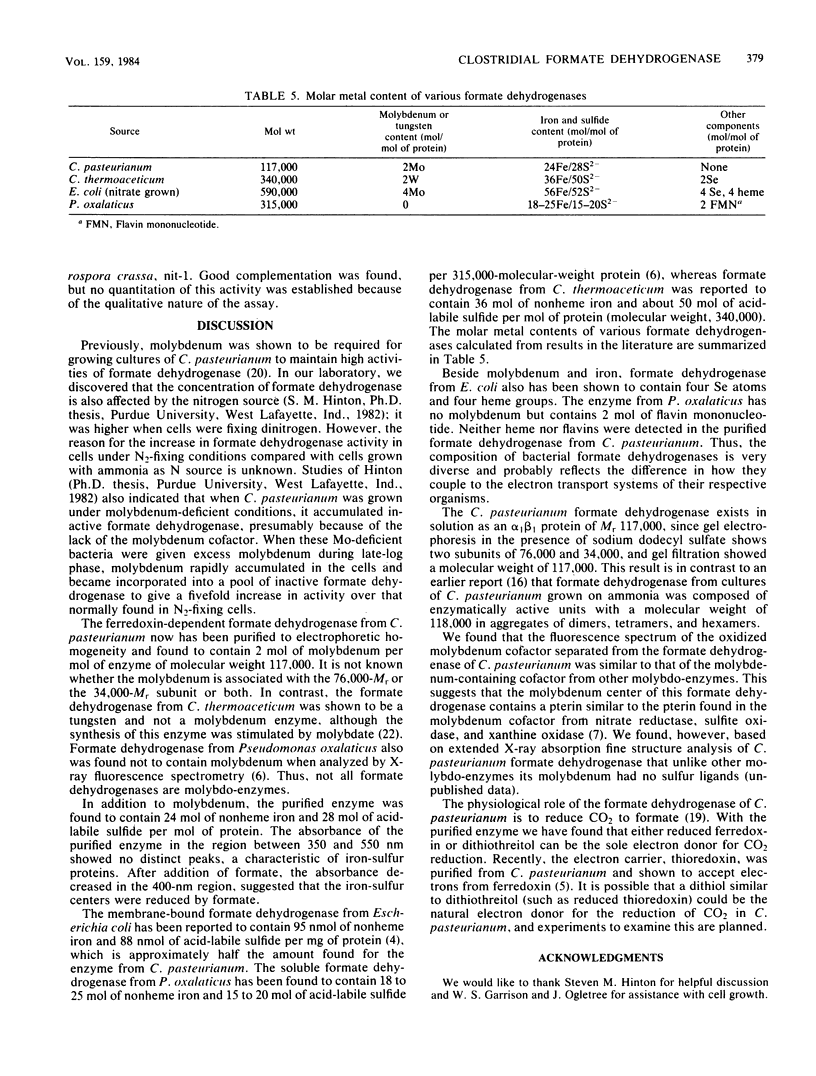Abstract
Formate dehydrogenase was purified to electrophoretic homogeneity from N2-fixing cells of Clostridium pasteurianum W5. The purified enzyme has a minimal Mr of 117,000 with two nonidentical subunits with molecular weights of 76,000 and 34,000, respectively. It contains 2 mol of molybdenum, 24 mol of nonheme iron, and 28 mol of acid-labile sulfide per mol of enzyme; no other metal ions were detected. Analysis of its iron-sulfur centers by ligand exchange techniques showed that 20 iron atoms of formate dehydrogenase can be extruded as Fe4S4 centers. Fluorescence analysis of its isolated molybdenum centers suggests it is a molybdopterin. The clostridial formate dehydrogenase has a pH optimum between 8.3 and 8.5 and a temperature optimum of 52 degrees C. The Km for formate is 1.72 mM with a Vmax of 551 mumol of methyl viologen reduced per min per mg of protein. Sodium azide competes competitively with formate (K1 = 3.57 microM), whereas the inactivation by cyanide follows pseudo-first-order kinetics with K = 5 X 10(2) M-1 s-1.
Full text
PDF





Selected References
These references are in PubMed. This may not be the complete list of references from this article.
- Amy N. K., Rajagopalan K. V. Characterization of molybdenum cofactor from Escherichia coli. J Bacteriol. 1979 Oct;140(1):114–124. doi: 10.1128/jb.140.1.114-124.1979. [DOI] [PMC free article] [PubMed] [Google Scholar]
- Brewer J. M., Ashworth R. B. Disc electrophoresis. J Chem Educ. 1969 Jan;46(1):41–45. doi: 10.1021/ed046p41. [DOI] [PubMed] [Google Scholar]
- Enoch H. G., Lester R. L. Formate dehydrogenase from Escherichia coli. Methods Enzymol. 1982;89(Pt 500):537–543. doi: 10.1016/s0076-6879(82)89093-9. [DOI] [PubMed] [Google Scholar]
- Hammel K. E., Cornwell K. L., Buchanan B. B. Ferredoxin/flavoprotein-linked pathway for the reduction of thioredoxin. Proc Natl Acad Sci U S A. 1983 Jun;80(12):3681–3685. doi: 10.1073/pnas.80.12.3681. [DOI] [PMC free article] [PubMed] [Google Scholar]
- Höpner T., Ruschig U., Müller U., Willnow P. Formate dehydrogenase from Pseudomonas oxalaticus. Methods Enzymol. 1982;89(Pt 500):531–537. doi: 10.1016/s0076-6879(82)89092-7. [DOI] [PubMed] [Google Scholar]
- Johnson J. L., Hainline B. E., Rajagopalan K. V. Characterization of the molybdenum cofactor of sulfite oxidase, xanthine, oxidase, and nitrate reductase. Identification of a pteridine as a structural component. J Biol Chem. 1980 Mar 10;255(5):1783–1786. [PubMed] [Google Scholar]
- Johnson J. L., Rajagopalan K. V. Structural and metabolic relationship between the molybdenum cofactor and urothione. Proc Natl Acad Sci U S A. 1982 Nov;79(22):6856–6860. doi: 10.1073/pnas.79.22.6856. [DOI] [PMC free article] [PubMed] [Google Scholar]
- Jungermann K., Kirchniawy H., Thauer R. K. Ferredoxin dependent CO-2 reduction to formate in Clostridium pasteurianum. Biochem Biophys Res Commun. 1970 Nov 9;41(3):682–689. doi: 10.1016/0006-291x(70)90067-7. [DOI] [PubMed] [Google Scholar]
- LOWRY O. H., ROSEBROUGH N. J., FARR A. L., RANDALL R. J. Protein measurement with the Folin phenol reagent. J Biol Chem. 1951 Nov;193(1):265–275. [PubMed] [Google Scholar]
- Ljungdahl L. G. Total synthesis of acetate from CO2 by heterotrophic bacteria. Annu Rev Microbiol. 1969;23:515–538. doi: 10.1146/annurev.mi.23.100169.002503. [DOI] [PubMed] [Google Scholar]
- MASSEY V. Studies on succinic dehydrogenase. VII. Valency state of the iron in beef heart succinic dehydrogenase. J Biol Chem. 1957 Dec;229(2):763–770. [PubMed] [Google Scholar]
- Mortenson L. E. Components of cell-free extracts of Clostridium pasteurianum required for ATP-dependent H2 evolution from dithionite and for N2 fixation. Biochim Biophys Acta. 1966 Sep 26;127(1):18–25. doi: 10.1016/0304-4165(66)90470-3. [DOI] [PubMed] [Google Scholar]
- Scherer P. A., Thauer R. K. Purification and properties of reduced ferredoxin: CO2 oxidoreductase from Clostridium pasteurianum, a molybdenum iron-sulfur-protein. Eur J Biochem. 1978 Apr;85(1):125–135. doi: 10.1111/j.1432-1033.1978.tb12220.x. [DOI] [PubMed] [Google Scholar]
- Schulman M., Parker D., Ljungdahl L. G., Wood H. G. Total synthesis of acetate from CO 2 . V. Determination by mass analysis of the different types of acetate formed from 13 CO 2 by heterotrophic bacteria. J Bacteriol. 1972 Feb;109(2):633–644. doi: 10.1128/jb.109.2.633-644.1972. [DOI] [PMC free article] [PubMed] [Google Scholar]
- Siegel L. M., Murphy M. J., Kamin H. Reduced nicotinamide adenine dinucleotide phosphate-sulfite reductase of enterobacteria. I. The Escherichia coli hemoflavoprotein: molecular parameters and prosthetic groups. J Biol Chem. 1973 Jan 10;248(1):251–264. [PubMed] [Google Scholar]
- Thauer R. K., Fuchs G., Jungermann K. Reduced ferredoxin: CO2 oxidoreductase from Clostridium pasteurianum: its role in formate metabolism. J Bacteriol. 1974 May;118(2):758–760. doi: 10.1128/jb.118.2.758-760.1974. [DOI] [PMC free article] [PubMed] [Google Scholar]
- Thauer R. K., Fuchs G., Schnitker U., Jungermann K. CO2 reductase from Clostridium pasteurianum: molybdenum dependence of synthesis and inactivation by cyanide. FEBS Lett. 1973 Dec 15;38(1):45–48. doi: 10.1016/0014-5793(73)80509-5. [DOI] [PubMed] [Google Scholar]
- Weber K., Osborn M. The reliability of molecular weight determinations by dodecyl sulfate-polyacrylamide gel electrophoresis. J Biol Chem. 1969 Aug 25;244(16):4406–4412. [PubMed] [Google Scholar]
- Yamamoto I., Saiki T., Liu S. M., Ljungdahl L. G. Purification and properties of NADP-dependent formate dehydrogenase from Clostridium thermoaceticum, a tungsten-selenium-iron protein. J Biol Chem. 1983 Feb 10;258(3):1826–1832. [PubMed] [Google Scholar]


